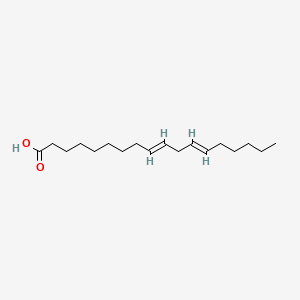Linoelaidic acid
Linoelaidic acid is a lipid of Fatty Acyls (FA) class. Linoelaidic acid is associated with abnormalities such as Obesity, Diabetes Mellitus, Non-Insulin-Dependent, Pneumonia, Chronic Obstructive Airway Disease and Metabolic syndrome. The involved functions are known as Metabolic Inhibition, Steroid biosynthesis, Signal Transduction, Insulin Resistance and Inflammation. Linoelaidic acid often locates in Mitochondria, Membrane and Cytoplasmic matrix. The associated genes with Linoelaidic acid are FFAR1 gene, C9orf7 gene, TNF gene, CCL2 gene and TLR4 gene. The related lipids are Fatty Acids, octadecadienoic acid, Steroids, methyl linoleate and Cyanoketone.
Cross Reference
Introduction
To understand associated biological information of Linoelaidic acid, we collected biological information of abnormalities, associated pathways, cellular/molecular locations, biological functions, related genes/proteins, lipids and common seen animal/experimental models with organized paragraphs from literatures.
What diseases are associated with Linoelaidic acid?
Linoelaidic acid is suspected in Obesity, Diabetes Mellitus, Non-Insulin-Dependent, Pneumonia, Chronic Obstructive Airway Disease, Metabolic syndrome and other diseases in descending order of the highest number of associated sentences.
Related references are mostly published in these journals:
| Disease | Cross reference | Weighted score | Related literature |
|---|
Possible diseases from mapped MeSH terms on references
We collected disease MeSH terms mapped to the references associated with Linoelaidic acid
PubChem Associated disorders and diseases
What pathways are associated with Linoelaidic acid
There are no associated biomedical information in the current reference collection.
PubChem Biomolecular Interactions and Pathways
Link to PubChem Biomolecular Interactions and PathwaysWhat cellular locations are associated with Linoelaidic acid?
Visualization in cellular structure
Associated locations are in red color. Not associated locations are in black.
Related references are published most in these journals:
| Location | Cross reference | Weighted score | Related literatures |
|---|
What functions are associated with Linoelaidic acid?
Related references are published most in these journals:
| Function | Cross reference | Weighted score | Related literatures |
|---|
What lipids are associated with Linoelaidic acid?
Related references are published most in these journals:
| Lipid concept | Cross reference | Weighted score | Related literatures |
|---|
What genes are associated with Linoelaidic acid?
Related references are published most in these journals:
- Prostaglandins Leukot. Essent. Fatty Acids (1)
- Thorax (1)
- Am. J. Physiol., Cell Physiol. (1)
- Others (1)
| Gene | Cross reference | Weighted score | Related literatures |
|---|
What common seen animal models are associated with Linoelaidic acid?
There are no associated biomedical information in the current reference collection.
NCBI Entrez Crosslinks
All references with Linoelaidic acid
Download all related citations| Authors | Title | Published | Journal | PubMed Link |
|---|---|---|---|---|
| Rondanelli M et al. | Effects of two-months balanced diet in metabolically healthy obesity: lipid correlations with gender and BMI-related differences. | 2015 | Lipids Health Dis | pmid:26511930 |
| Ellero-Simatos S et al. | Oxylipid Profile of Low-Dose Aspirin Exposure: A Pharmacometabolomics Study. | 2015 | J Am Heart Assoc | pmid:26504148 |
| Ressurreição M et al. | Sensory Protein Kinase Signaling in Schistosoma mansoni Cercariae: Host Location and Invasion. | 2015 | J. Infect. Dis. | pmid:26401028 |
| Delmastro-Greenwood M et al. | Nitrite and nitrate-dependent generation of anti-inflammatory fatty acid nitroalkenes. | 2015 | Free Radic. Biol. Med. | pmid:26385079 |
| Turci F et al. | Free-radical chemistry as a means to evaluate lunar dust health hazard in view of future missions to the moon. | 2015 | Astrobiology | pmid:25946080 |
| Dahlhoff M et al. | EGFR/ERBB receptors differentially modulate sebaceous lipogenesis. | 2015 | FEBS Lett. | pmid:25889637 |
| Gouveia-Figueira S et al. | Serum levels of oxylipins in achilles tendinopathy: an exploratory study. | 2015 | PLoS ONE | pmid:25875933 |
| Mansour AB et al. | Effect of agricultural sites on differentiation between Chemlali and Neb Jmel olive oils. | 2015 | J Oleo Sci | pmid:25833451 |
| Alnaseri H et al. | Inducible Expression of a Resistance-Nodulation-Division-Type Efflux Pump in Staphylococcus aureus Provides Resistance to Linoleic and Arachidonic Acids. | 2015 | J. Bacteriol. | pmid:25802299 |
| Chen S et al. | Profiling of volatile compounds and associated gene expression and enzyme activity during fruit development in two cucumber cultivars. | 2015 | PLoS ONE | pmid:25799542 |
| Vlachogianni IC et al. | In vitro assessment of antioxidant activity of tyrosol, resveratrol and their acetylated derivatives. | 2015 | Food Chem | pmid:25660873 |
| Chan BC et al. | Combating against methicillin-resistant Staphylococcus aureus - two fatty acids from Purslane (Portulaca oleracea L.) exhibit synergistic effects with erythromycin. | 2015 | J. Pharm. Pharmacol. | pmid:25212982 |
| Perumalsamy H et al. | Larvicidal activity and possible mode of action of four flavonoids and two fatty acids identified in Millettia pinnata seed toward three mosquito species. | 2015 | Parasit Vectors | pmid:25928224 |
| Nakahashi H et al. | Evaluation of the Key Odorants in Volatile Oils from Tubers of Apios americana Medikus. | 2015 | J Oleo Sci | pmid:26521814 |
| Naughton SS et al. | Australia's nutrition transition 1961-2009: a focus on fats. | 2015 | Br. J. Nutr. | pmid:26123446 |
| Salazar MO et al. | A thin-layer chromatography autographic method for the detection of inhibitors of the Salmonella PhoP-PhoQ regulatory system. | 2014 Mar-Apr | Phytochem Anal | pmid:24185747 |
| Fritsche KL | Linoleic acid, vegetable oils & inflammation. | 2014 Jan-Feb | Mo Med | pmid:24645297 |
| Hodson L et al. | Plasma and erythrocyte fatty acids reflect intakes of saturated and n-6 PUFA within a similar time frame. | 2014 | J. Nutr. | pmid:24225449 |
| Purushothaman D et al. | Flaxseed oil supplementation alters the expression of inflammatory-related genes in dogs. | 2014 | Genet. Mol. Res. | pmid:25078588 |
| Shen J et al. | A 13-lipoxygenase, TomloxC, is essential for synthesis of C5 flavour volatiles in tomato. | 2014 | J. Exp. Bot. | pmid:24453226 |
